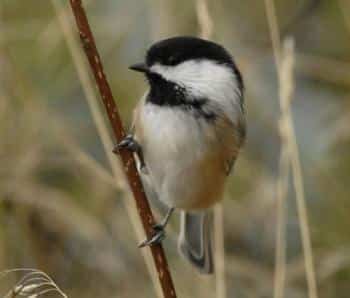Spring, the Singingest Season

Black-capped Chickadee
Photo credit: Jim Williams
by Val Cunningham
Contributing Writer
Chickadees and cardinals sing lilting songs, but their meaning may be in the ear of the beholder
The bird-song orchestra is tuning up for spring. House finches chortle from treetops, goldfinches sing loudly from perches and sparrows twitter loudly in shrubbery.
Two of the most persistent songsters at this time of year are the familiar northern cardinal and black-capped chickadee. These birds are fairly circumspect during the winter but now are bursting forth in exuberant song.
During the cold months cardinals seemed relatively indifferent to other cardinals. They gathered in groups of a dozen or more at good sources of food or water without raised crests or other threatening behavior. Chickadees spent the winter together in flocks, sharing the news when one discovered a good cache of insect eggs or berries.
But the time for peaceful coexistence is over. With spring approaching and hormones ramping up, resident songbirds now are sending out songs either to cajole or threaten. Male chickadees sing “fee-bee” to entice a female to leave the flock and set up housekeeping. That same call, whistled more loudly by a male, can also mean, “Stay away from this side of the yard, buddy!”
The cardinals filling the brisk spring air with their exuberant “wha-cheer” song are engaging in early courtship behavior, too, but with a twist: both males and females are singing, unusual in the world of songbirds. Cardinal pairs sing duets, burbling “purdy, purdy, purdy, wheet, wheet, wheet,” back and forth, before moving on to other combinations in their repertoire. While songs in early spring are part of the courtship ritual, they later become aural fences, spilling out a cardinal pair’s sense of the territory it intends to defend.
Spring is really all about territory, since this is a major factor in determining how many young birds survive to leave the nest. The two vital characteristics of a good territory are plenty of insects to feed nestlings and plenty of shrubs and trees for hiding from predators.
Cardinals, chickadees and other “winter” birds will have carved up the local real estate by the time migratory birds begin returning in May. As migrants flood in, hurrying to find a mate and establish their own territories, do they have to settle for whatever space is left?
Mother Nature has thought this out. Songbirds sing to entice or warn to their own kind: cardinals don’t want other cardinals setting up housekeeping nearby, invading the niche they’ve carefully cultivated. Same for chickadees, who worked hard to find a nice tree hole and don’t want other chickadees invading their space.
But cardinals and chickadees don’t much care what other species are doing. They’ll tolerate orioles when these arrive, warblers when they dash through and bluebirds on the hunt for beetles. These other species have their own particular food and nest specifications and are not regarded as competitors by our resident birds.
During the busy nesting season, when birds drive themselves almost to exhaustion, they sing less often and more softly. These “pianissimo” songs of cardinals and chickadees may be telling a mate that they’re bringing food in to the nest.
Birds must learn the songs sung by their species, so the sounds of late summer and fall are often uttered by youngsters practicing the same notes over and over until a song matches their mental template. Like a kid learning to play the violin, these sounds can be discordant, until, with practice, they become music to our ears.
St. Paul, Minnesota resident Val Cunningham, leads bird hikes for the St. Paul Audubon Society and writes about nature for local, regional and national newspapers and magazines.



